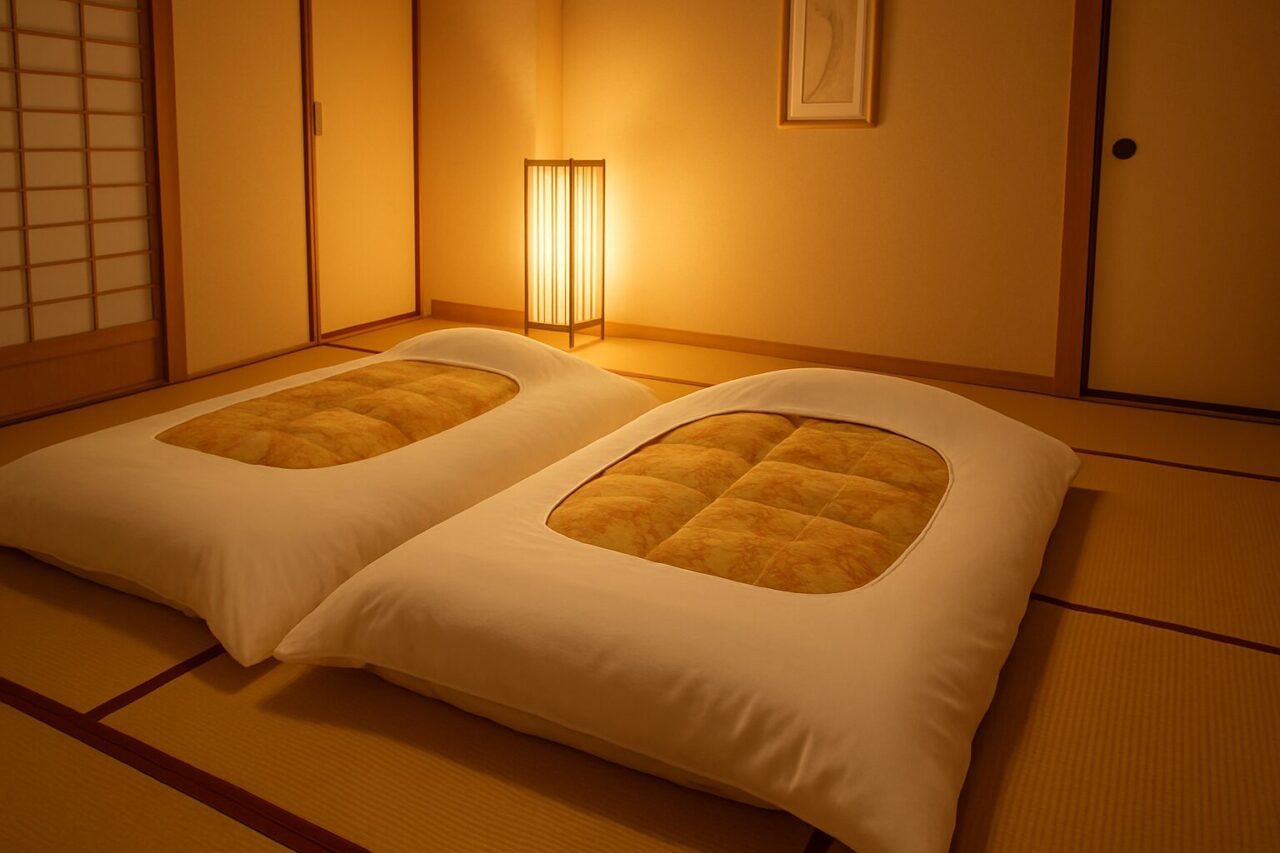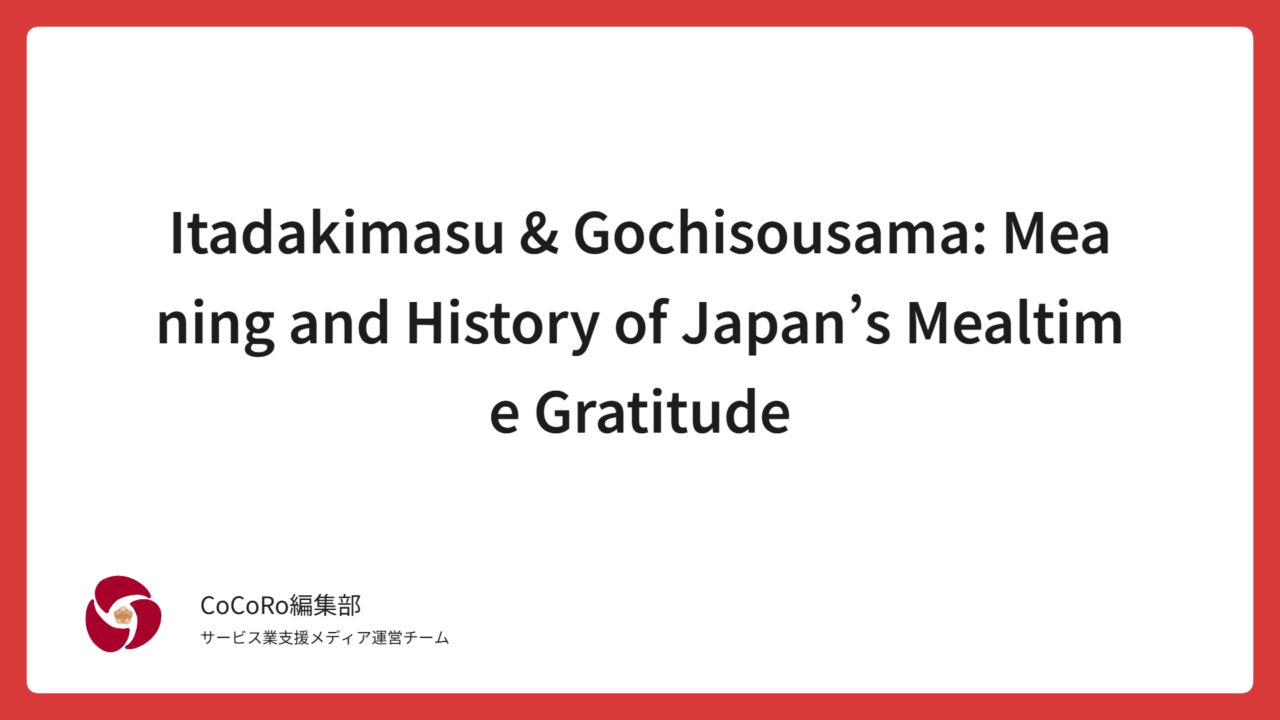
- Why Many International Travelers Are Surprised That Ryokans Have No Beds
- How Japan’s Bedding Culture Began: Sleep Styles from Ancient to Medieval Times
- The Origin of the Word “Futon”: How a Buddhist Seat Became Japan’s Iconic Bedding
- Why Futon Spread During the Edo Period: Cotton Production Transformed Daily Life
- Why Futon Remained Popular Even After Beds Arrived in Japan (Meiji–Shōwa Era, 1868–1989)
- The “Tatami and Futon” Sleep Culture Experienced in Ryokans
- Modern Futon and the Evolution of Japanese Bedding: Materials, Functionality, and New Uses
- The Future of Bedding: A Lifestyle That Prioritizes Space and Comfort
- Conclusion: Futon as a Symbol of Japanese Living Culture
Why Many International Travelers Are Surprised That Ryokans Have No Beds
One of the first things that surprises international travelers when they stay at a Japanese ryokan is the absence of a bed in the room. Upon entering, they find a spacious tatami-floored area with a low table and floor cushions, but no visible sleeping space. In the evening, staff quietly set out the futon, and by the next morning it is neatly put away again—returning the room to what looks like a living space. For many visitors, this idea of a room that transforms between day and night feels remarkably new and fascinating.
In many countries, the bedroom has a fixed and singular purpose, and the bed is always a permanent piece of furniture. Sleeping spaces and living areas are clearly separated, and the layout of the room is organized around that distinction. For travelers who are used to this arrangement, the spatial design of a Japanese ryokan—where the same room serves different functions depending on the time of day—can feel both surprising and deeply intriguing.
The continued use of futon in ryokans is closely tied to Japan’s lifestyle, traditional architecture, and climate. In Japan, a futon is more than a piece of bedding—it plays an essential role in how rooms are used and how the daily rhythm of living spaces is organized. From here, we look at how Japanese bedding evolved over time and why the futon tradition has remained firmly in place even in the modern era.
How Japanese Living Spaces Transform Between Day and Night
In a traditional ryokan room, the space serves as a spacious living area during the day, and then transforms into a bedroom at night when the futon is laid out. This flexible use of a single room—without assigning it to one fixed purpose—is a distinctive feature of Japanese living culture. Because the room is not crowded with large furniture, the space remains open and uncluttered, and bedding is brought out only when needed. This creates a natural and highly adaptable way of using the room that many visitors find both practical and refreshing.
This flexibility is also a practical way to make the most of limited living space. Because there is no need to keep a bed in the room at all times, the space remains open during the day and the overall flow of daily life stays clean and uncluttered.
The Fundamental Differences Between Japanese and Western Bedroom Culture
In many Western countries, the bed is treated as a central and permanent piece of furniture, rarely moved or put away. Bedrooms are designed with the assumption that a bed will always occupy the space. In contrast, Japanese homes traditionally use tatami floors and foldable futon bedding, which can be stored away during the day. This has shaped a culture where living spaces naturally shift functions depending on the time of day.
This contrast reflects more than just a difference in bedding—it represents a fundamentally different way of thinking about how living spaces should function.
Why Many Travelers Are Surprised by the Futon Service in Ryokans
At a ryokan, it’s common to return to your room after dinner and find the futon neatly laid out—an experience that many travelers find memorable in itself. By the next morning, the bedding is already put away, and the room is restored to a spacious living area. This unique practice, where staff help transition the space between day and night, is something rarely seen in Western-style hotels. It is often praised by international guests as a distinctive and thoughtful aspect of the ryokan experience.
How Japan’s Bedding Culture Began: Sleep Styles from Ancient to Medieval Times
Japan’s bedding culture developed gradually from ancient through medieval periods. Modern-style futon did not exist at the time; instead, people slept on simple bedding made from natural materials such as straw or animal hides. These early sleeping practices were deeply influenced by Japan’s climate, wooden architecture, and the way homes were designed to breathe and adapt to seasonal changes.
Primitive Bedding: Straw Mats, Rush Sheets, and Animal Hides
In ancient Japan, people typically slept by laying out rush mats (mushiro) or straw directly on the floor and lying down on top of them. These materials were lightweight, easy to handle, and could be aired out when needed—an important advantage in Japan’s humid climate. In colder regions, animal hides were used to retain warmth and provide a layer of insulation during the night.
Because Japan is highly humid, leaving bedding on the floor for long periods can quickly lead to mold and hygiene issues. As a result, a cultural habit of airing out and storing bedding naturally developed, laying the foundation for later practices surrounding the care of futon.
How Traditional Architecture Shaped a Floor-Centered Lifestyle
Japanese homes were traditionally built using a post-and-beam structure, which naturally limited the development of interiors filled with large, heavy furniture. Daily activities—sitting, eating, relaxing, and sleeping—were all performed close to the floor, making the floor itself the center of daily life.
Living close to the floor also made it easier to keep rooms open and spacious. This approach suited the Japanese emphasis on using limited space efficiently, allowing a single room to serve multiple functions without being constrained by permanent furniture.
How the Arrival of Tatami Transformed Japanese Living Spaces
The earliest form of tatami appeared during the Heian period, though it was initially used only by the aristocracy and placed in small sections of a room. It wasn’t until the Edo period that tatami began to cover entire rooms, becoming a standard feature of Japanese homes.
Tatami offered excellent insulation and natural humidity control, making it an ideal surface for a lifestyle centered around the floor.
As tatami spread, sleeping practices also evolved, eventually giving rise to the custom of laying out futon bedding—a tradition that continues in many Japanese homes and ryokans today.
The Origin of the Word “Futon”: How a Buddhist Seat Became Japan’s Iconic Bedding
The word futon has its roots in Buddhism. The original term, “futon” (蒲団), referred not to bedding but to a round cushion used during seated meditation, especially in Zen practice. Over time, the name of this meditation cushion was adopted for the padded bedding that later developed in Japan, eventually becoming the familiar futon known today.
The Buddhist “Futon” as a Meditation Seat
The original futon—written as 蒲団—was a round cushion used for seated meditation. It was stuffed with the soft, cotton-like fibers of the gama (cattail) plant, and served purely as a tool for sitting during Buddhist practice. Although this cushion provided the name for modern bedding, it was entirely separate from what people slept with at the time.
The Reality of Sleeping Under Layered Kimono
Before padded bedding became common, ordinary people slept by pulling their kimono over themselves. Even when layered, kimono offered far less insulation than a modern futon, making winter nights exceptionally cold. There were also yogi, kimono-shaped sleeping garments, but these contained very little padding, meaning they provided only minimal warmth. For most people, staying warm at night was a constant challenge until stuffed bedding—what we now call futon—spread in later centuries.
A Historical Comparison with Western and Chinese Bed Culture
In Western countries and in China, wooden raised beds became common relatively early. Sleeping above the floor offered better hygiene, improved airflow, and protection from cold and damp conditions. Japan, however, maintained a floor-centered way of living for many centuries. As a result, Japanese bedding evolved along a completely different path—one that eventually led to the development of the futon culture seen in ryokans and traditional homes today.
Why Futon Spread During the Edo Period: Cotton Production Transformed Daily Life
The Edo period marked a turning point in Japan’s sleeping culture. As cotton production expanded, warm and padded cotton-filled futon became widely accessible—even to ordinary townspeople. This shift replaced the simpler bedding materials used in earlier centuries and dramatically improved comfort during cold seasons.
The Growth of Cotton Cultivation and Distribution
By the mid-Edo period (around the 18th century), cotton was being cultivated widely across Japan. As distribution networks developed, cotton-based textiles became common in everyday life. Soft, breathable, and highly insulating, cotton proved ideal for bedding—laying the foundation for the modern futon used today.
The Birth and Spread of Cotton-Filled Futon
Once cotton became widely available, people began creating padded bedding by enclosing cotton inside fabric—resulting in early versions of today’s kake-buton (comforter) and shiki-buton (mattress). These cotton-filled futon were warm, easy to handle, and could be stored in a closet during the day, making them perfectly suited to the flexible use of space in Japanese homes.
Cotton Beaters and the Culture of “Uchinaoshi” (Bedding Renewal)
Over time, the cotton inside futon naturally became compacted and firm. To restore it, specialized craftsmen called wata-uchi (cotton beaters) performed a process known as uchinaoshi, in which the cotton was fluffed and revived for reuse. This practice of renewing and reusing materials reflects a broader Japanese cultural value: making the most of limited resources and extending the life of everyday items.
Built-in Closets and the Japanese Home: Why Futon Fit Perfectly
Because futon can be folded and stored in a oshiire (built-in closet) when not in use, the room instantly becomes open and multipurpose. This high level of storability and flexibility is one of the major reasons why futon became deeply rooted in Japanese daily life—it allowed people to keep living spaces spacious during the day while still ensuring a comfortable sleeping setup at night.
Why Futon Remained Popular Even After Beds Arrived in Japan (Meiji–Shōwa Era, 1868–1989)
Western-style beds were introduced to Japan during the Meiji era (1868–1912) as Western culture rapidly entered the country. Even so, the futon tradition remained firmly rooted throughout the Shōwa era (1926–1989). This persistence was not due to resistance to change, but rather because Japan’s unique environment, climate, and lifestyle were already well-suited to futon—a bedding style that complemented the way Japanese homes were designed and lived in.
A Humid Climate Made Futon the Most Practical Choice
Japan’s high humidity makes it easy for moisture to build up in bedding if it is left on the floor for long periods. This can quickly lead to mold or dust mites. Futon, however, can be easily aired out in the sun, helping keep them dry, clean, and comfortable. This made futon an ideal bedding solution for Japan’s climate long before modern dehumidifiers existed.
Maximizing Space in Compact Homes
In urban areas, where living space is often limited, it’s important to use rooms as efficiently as possible without adding unnecessary furniture. Because futon can be folded and stored away during the day, the living area instantly becomes open and spacious. This flexibility made futon a highly practical choice for modern Japanese homes and contributed to its continued popularity even after Western beds were introduced.
How Ryokan Culture Helped Sustain Japan’s Futon Tradition
For centuries, ryokans have preserved the pairing of tatami rooms and futon bedding, making it a defining feature of Japanese hospitality.
The experience of sleeping on futon in a calm, uncluttered tatami room continually reinforces the appeal of this tradition—both for locals and for international travelers.
By maintaining this style of accommodation, the hospitality industry has played a significant role in keeping futon culture alive and passing it on to future generations.
The “Tatami and Futon” Sleep Culture Experienced in Ryokans
The sleep experience in a ryokan is a symbol of Japan’s unique lifestyle and living traditions. For many international travelers, the most memorable part of their stay is the combination of tatami flooring and futon bedding, which feels entirely different from Western-style hotel rooms.
Why Tatami Serves as Both Flooring and Furniture
Tatami offers excellent insulation and natural moisture control, making it a comfortable surface to walk on barefoot. At the same time, it functions almost like furniture—you can sit directly on it, relax, or even sleep on it with a futon. This multifunctionality is a major reason tatami has become so deeply rooted in Japanese living culture, shaping the way people interact with their homes and with the space around them.
How the Timing of Laying Out Futon Became a Cultural Habit
The custom of spreading out the futon in the evening and putting it away in the morning developed as a practical way to keep rooms spacious during the day. In ryokans, this routine has been elevated into a form of hospitality: staff prepare the bedding after dinner and tidy it away in the morning so guests can enjoy a clean, open space without any effort on their part.
Common Reactions and Praise from International Travelers
Many international guests share their surprise—and often delight—after experiencing this style of sleeping. Reviews frequently mention comments such as: “It was more comfortable than I expected,” “The smell of tatami was calming,” “It was fascinating to see the room transform between day and night.” For many travelers, sleeping on a futon in a tatami room becomes a highly memorable part of their trip, offering a firsthand glimpse into Japan’s traditional lifestyle and spatial culture.
Modern Futon and the Evolution of Japanese Bedding: Materials, Functionality, and New Uses
Today’s futon and bedding have evolved dramatically. They now come in a wide range of materials and functions, allowing people to choose what best suits their lifestyle, climate, and personal comfort.
Down, Synthetic, and Washable Futon: Expanding Options for Modern Living
Down futon are lightweight yet remarkably warm, making them a popular choice for winter. Bedding made with synthetic fibers is even lighter, easy to wash, and often designed with allergy-friendly features—an important improvement for households prioritizing cleanliness and convenience. Thanks to these advances, modern Japanese homes now enjoy bedding that is clean, easy to maintain, and adaptable to different living environments, while still retaining the core ideas of the traditional futon.
The Difference Between a Shiki-Futon and a Mattress: Sleep Quality and Body Alignment
A shiki-futon pairs well with tatami because its moderate firmness makes it easy to turn over during sleep, helping maintain natural posture throughout the night. If the floor feels too hard, a thin mattress or topper can be added for extra cushioning—an option that highlights the flexibility and adjustability unique to futon-based sleeping arrangements.
Requirements for Futon Used in Ryokans and Hotels
Futon designed for professional hospitality settings must be highly durable, easy to clean, and hygienic. Because inns and hotels wash, air out, and rotate their bedding frequently, the materials and construction are carefully selected to ensure long-lasting performance while meeting strict cleanliness standards. These industry-specific requirements help maintain the comfort and reliability that travelers expect from Japanese-style accommodations.
Understanding the Difference Between Japanese “Futon” and the Western “FUTON”
Outside Japan, the word “FUTON” usually refers to a foldable sofa-bed—something closer to a convertible couch than traditional Japanese bedding. Its structure, purpose, and materials are entirely different from the lightweight, foldable futon used on tatami floors in Japan. Clarifying this distinction helps highlight the unique qualities of Japan’s sleeping culture and prevents common misunderstandings among international travelers.
The Future of Bedding: A Lifestyle That Prioritizes Space and Comfort
In modern homes, there is a growing desire to use living space more efficiently. Because futon can be folded and stored away, they help keep rooms open and uncluttered—making them a practical choice even for contemporary lifestyles. As people continue to value flexibility, comfort, and clean living environments, the principles behind traditional futon culture remain surprisingly relevant today.
Why Futon Is Being Rediscovered: Space Efficiency and Smart Storage
In urban areas where living space is limited, choosing a futon instead of a permanent bed can make a room feel significantly larger. As more people embrace simpler, uncluttered lifestyles, futon are gaining renewed attention for their ability to maximize space while supporting a flexible way of living.
The Comfort of Natural Materials
Traditional Japanese homes integrate natural materials such as tatami, wood, and cotton, all of which offer excellent breathability, humidity control, and insulation. These elements create a sleep environment that feels calm, balanced, and seasonally adaptable. The practice of adjusting bedding according to the time of year—switching between lighter summer futon and warmer winter ones—remains a practical tradition that continues to support comfortable, healthy sleep.
How Ryokan Experiences Are Spreading Interest in Japanese-Style Sleep
Travelers who experience the comfort of futon in a ryokan often return home wanting to recreate the same sleeping environment. As interest grows in minimalist living, natural materials, and flexible use of space, Japanese-style sleep setups are attracting increasing attention around the world. For many visitors, a single night on a futon becomes the starting point for exploring a sleep style that feels refreshingly simple, calm, and deeply connected to everyday Japanese culture.
Conclusion: Futon as a Symbol of Japanese Living Culture
Futon is far more than a piece of bedding. It reflects Japan’s approach to space, traditional architecture, and adaptation to a humid climate—all essential elements of everyday life. The experience of sleeping on tatami with futon in a ryokan showcases a practical and culturally rooted style of living, offering international visitors a fresh and memorable glimpse into Japanese daily life.
Japan’s bedding culture will continue to be passed down through both ryokans and private homes, preserving a lifestyle that values flexibility, spatial efficiency, and harmony with the environment. As living spaces evolve, the wisdom behind the futon tradition will remain relevant for years to come.






